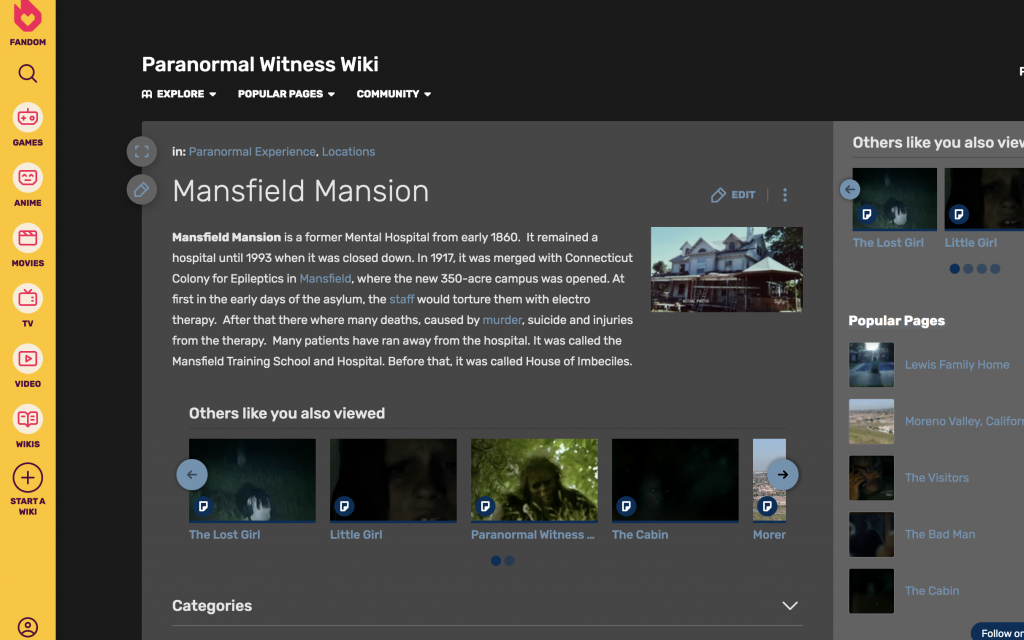By: Jess Gallagher
“[D]espite the mostly positive, caring work that went on here
(and at other similar facilities), there seems to be a story or two of negative incidents,
any one of which is enough to initiate stories
of restless souls and troubled spirits.”
–Damned Connecticut
“Mansfield Training School has gotten plenty of attention,
for it is believed to be haunted.”
–Abandoned Playgrounds
“A former mental asylum still haunted by its victims…
Dead animal bones littered the area.
Old dressers, beds, and a wheelchair were strewn all over.
The antique board reading “The Mansfield Training School”
–Syfy’s Paranormal Witness “The Haunting of Mansfield Mansion”
It was around 8:30 p.m. on a Monday night in early March. I sat at my desk in our school newspaper’s office. Since I had finished copyediting a good portion of my work for next day’s paper, I spent the rest of my free time line-editing a draft of my honors thesis on Mansfield Training School. Of course, while this was months later than my initial research on the institution, there were still more than a few questions that were left unanswered despite the amount of archival work that we had done. So, naturally, whenever I hear the words “Depot Campus” come out of someone’s mouth I instantly start listening, but I normally always hear the same conversation repeated…
“Oh yeah, have you guys ever been to the Depot campus before.”
“No, what’s that?”
“Isn’t that where the puppet place is?”
“Yeah, I heard it’s pretty haunted.”
This is how most of the conversations I overhear go. And, while it’s interesting to hear people actually talking about Mansfield Training School, this specific conversation really made me start thinking about hauntings and the implications that these narratives have on the past. Though the “haunted” articles on Mansfield Training School outweighed the history on my initial search of the school I really didn’t think much of it. It’s so common after all.

Growing up, I always listened to stories about old hospitals, abandoned prisons, and “insane” asylums. My friends and I watched Paranormal Witness, The Haunted, and Ghost Hunters. And while these shows did tell us a little bit about the history of the buildings and sites they investigated, the main emphasis was on the demonic, the anger, the aggression, and the ‘ghosts’ rather than the people who endured the abuse, suffering, and oppression that those in power inflicted on them.
In a way, we almost fail to understand the social impact that articles on “hauntings” have when it comes to the United States’ history of institutionalization. Viewing historical sites as “haunted” almost creates distance between the true history of the institutions and (if done frequently enough) can erase the humanity of the people who come to be labeled as just the institution’s “victims.” They become faceless.
It seems that through the rhetoric utilized when talking about institutionalization if we center hauntings rather than investigate the histories of the “victims” or objects of said haunting, we can lose valuable information that critiques past behaviors and actions, attitudes, and ideals, or spatial and cultural norms that inflicted abuse and supported the oppression of millions of marginalized identities.
Of course, there is always a degree of temporal distance associated with sites such as Mansfield Training School and its history, but if we use distance and re-frame it as a means to gain clarity and perspective that comes with the passage of time then we can establish a relationship of engagement and insight that can connect us to a past that has long been erased.
I am in no way, of course, shaming or demeaning the entire genre of ‘ghost stories’ or ‘hauntings’ by talking about the potential harmful effects that can come when we center and sensationalize paranormal narratives over history and people of the past. The attention garnered by these paranormal stories could very well serve as a launching point for where we, as activists and scholars, can begin working.
But, we must first be conscious of the distance being created (both socially, historically, and culturally) in these paranormal narratives and only then can we truly examine ‘sites of hauntings’ as ‘sites of history.’ In changing that perspective, scholars, activists, and investigators can uplift the stories and histories of those who lost their lives at these institutions.
When we come to understand the history of institutions like Mansfield Training School, we understand that it was not just a place with “mostly positive, caring work” being conducted that just happens to have one or two angry spirits (like Damn Connecticut would have us believe). Instead, we uncover the politics, experimentation, and cross-institutional connections that went on here and in dozens of institutions across the state of Connecticut.
While ghost stories and narratives of the paranormal will always remain, I think it’s important that we remain cognizant of the people behind these narratives, their histories, and work to advocate against modern-day forms of institutionalization that currently exist in our society. If not, then years from now, we may see our own history become one of the many haunted stories of the past…